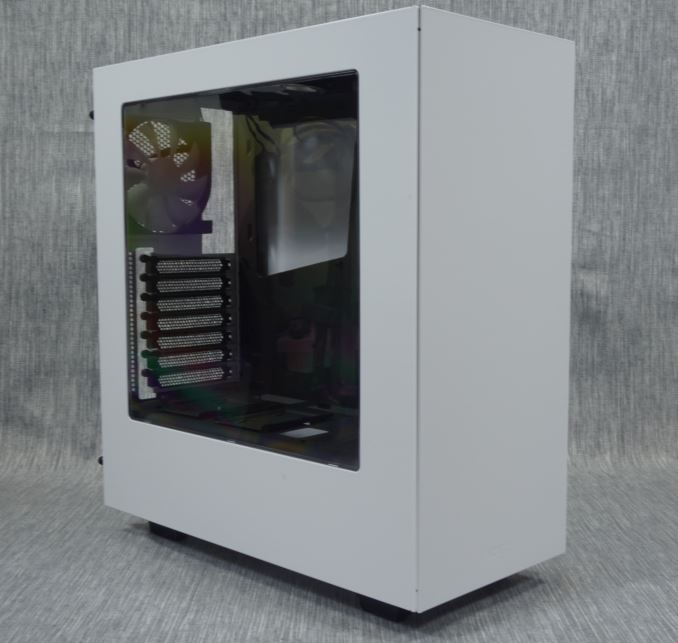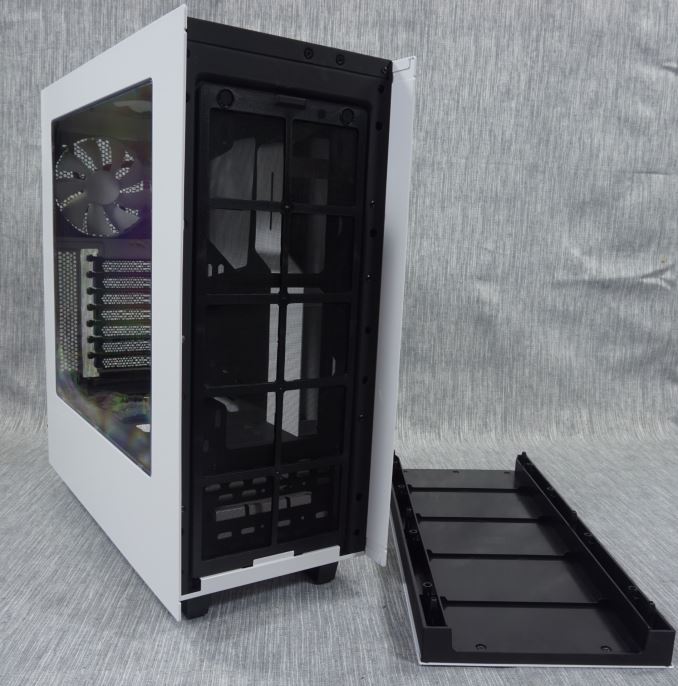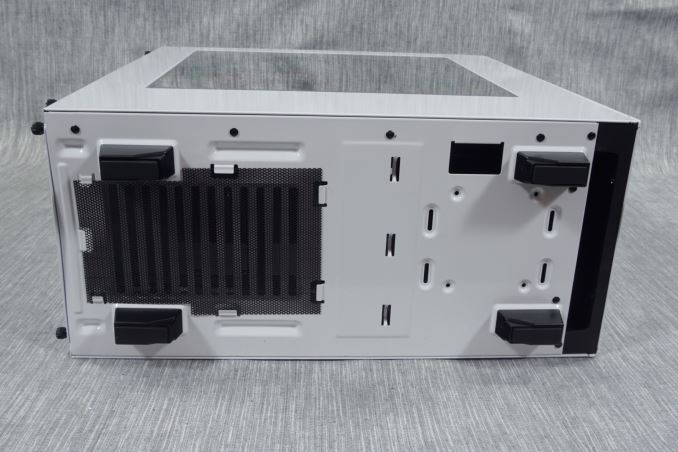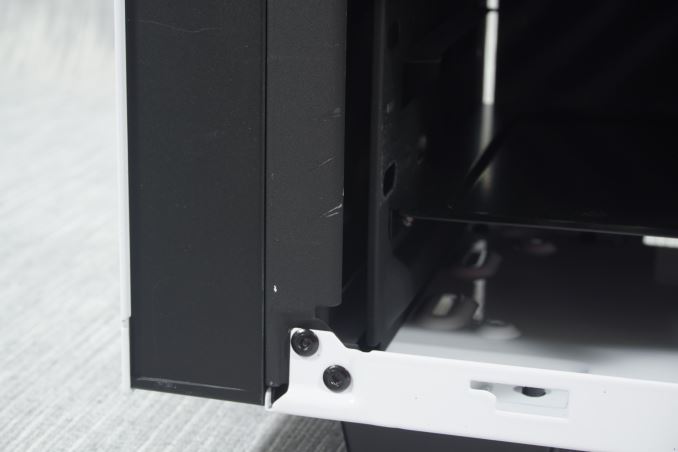The NZXT S340 Case Review
by E. Fylladitakis on July 13, 2015 8:00 AM EST- Posted in
- Cases/Cooling/PSUs
- NZXT
- Case
- ODD-Free
The Exterior of the NZXT S340
In terms of design, the S340 is just about as minimalistic as it gets. It literally is just a rectangular metallic box, with an entirely flat faceplate and side panels. Even the company logo that is embossed near the bottom of the faceplate is difficult to discern. We received the white version of the S340, which has a glossy exterior with matte black accents and a black interior. The left side panel of our sample is partially windowed, revealing the entire system compartment but leaving out the area where the PSU and the 3.5” drives are.
As we anticipated, the metallic faceplate is just a sheet of metal attached on a thick plastic frame. This is natural for both practical reasons and considering the price of the case. The flexibility of plastic allows for panels that can be easily attached to and removed from the metallic frame of the case, whereas a metallic construct would be heavy and it would definitely require some sort of locking mechanism or screws to stay in place. A very large nylon air filter covers the entire front of the case behind the front panel. As we mentioned in the introduction, there is not a single 5.25” device bay.
One of NZXT's primary marketing points regarding the S340 is its compact size. True enough, the S340 is very small for a tower case, with a volume of just 0.0384 cubic meters. This makes it even smaller than the Corsair Obsidian 350D (0.0416m3, 8% greater volume), a case that is limited up to micro ATX motherboards. It also is much smaller than the SilverStone Fortress FT05 (0.0456m3, 17.15% greater volume), which also is an "ODD-Free" design. The extensive use of steel makes the S340 a relatively slightly heavy case for its size, tipping the scales at 7 kg while completely empty.
Even though the interior of the case is black, the rear and bottom of the frame are sprayed with the same glossy white color as the faceplate and side panels. The PSU compartment is at the bottom of the case, where four thumbscrews are holding a cover in place. As we will see later, the PSU can only be installed by taking off this cover and inserting a PSU from the back of the case. A very basic metallic mesh filter can be found at the bottom of the case, covering the opening of the PSU intake. It also is noteworthy that the S340 has slightly tall feet for a case of this design and size.
The top of the S340 is matte black with all versions of the case, including the white version that we received for this review. The power on button, two USB 3.0 ports and the two headphone jacks can be found at the right front edge of the top panel. A LED ring surrounds the power on button, serving as the power on indicator.
The matte black color of the top and the interior of the case is very smooth and has an excellent feel to the touch. However, it also is very easy to scratch. This will be particularly obvious on the front frame, where the latches of the side panels lock. The matte paint at the sides of the front frame was already scratched when we removed them for the first time. One should be very, very careful when working with the S340, especially around its interior.

















48 Comments
View All Comments
zepi - Monday, July 13, 2015 - link
Why are these cases so huge in terms of depth? I'd think that removal of 5.25" and 3.5" bays would allow for much more compat case designs.Shadow7037932 - Monday, July 13, 2015 - link
Depth in which direction? If you're talking about making the case thinner sideways, then the reason is because people want to put large tower heatsinks.zepi - Monday, July 13, 2015 - link
Depth in terms of measure from front to back.Shadow7037932 - Monday, July 13, 2015 - link
To fit larger longer GPUs and radiators.mr_tawan - Monday, July 13, 2015 - link
It's for 240mm radiator.Haravikk - Monday, July 13, 2015 - link
Do we really need a 36cm deep case to fit a 240mm radiator? The 90º folds in the chassis should be able to support holes for mounting a radiator, so a depth of 26cm ought to be plenty, for GPU compatibility 30cm probably makes sense (with the PCI brackets extending out the back).I suppose the same question can be asked of why not a Mini ITX motherboard though; it's rare to see anyone actually needing more than one PCIe slot, as IMO it's usually better to just get a single card and upgrade it later, as multi-card setups are almost always disappointing.
I do wish we'd get away from the longer cards actually, as there are too few good half-length offerings, though the 960 from Nvidia and the new Nano from AMD seem like good options. What we really need are more shorter cards with liquid cooling integrated, as it really opens up the possibilities for smaller systems.
niva - Monday, July 13, 2015 - link
Your points are all valid, but in general I feel desktops should keep their size. Laptops and tablets, even cell phones are taking over in terms of compact computing. The charm of the desktop is that it still has the big bays for DVDs and hard drives and giant radiators/fans.Pretty soon we should be able to get rid of the big optical drives though, they're already on the way out. The mass storage devices can be relocated and overall I agree with your suggestions.
I also find multi GPU setups not worth the risk and cost, prefer to get a high end card and keep it for a few years. The large cards are difficult to fit in all cases.
powerwiz - Tuesday, July 14, 2015 - link
What risks are you talking about in terms of mutli GPU set up. Its rather simple and with say the Nvidia 900 series cards your talking about almost half of the power consumption of previous generation cards. I have a MSI 980 GTX SLI set up it was cake to put in. On top of that the cards are near silent in everyday computing. Even with games running max its still pretty quite compared to cards of the past.Also this case was never geared towards you its geared towards a computer enthusiast. I recently built a monster gaming rig using the NZXT H440. While it looks somewhat traditional it lacks all bays for various legacy drives. Internally its been covereted into HDD/SSD slots.
Also if you do not like this case there is a tremendous selection of many other slim cases, micro cases etc.
Kepe - Monday, July 13, 2015 - link
"it's rare to see anyone actually needing more than one PCIe slot"I have a GPU, PCIe SSD and a PCIe sound card. No way I'd manage with just one PCIe slot. Mini ITX lacks expandability. You buy a new Mini ITX system and are happy with it for a while. Then you start thinking about some additions, like a sound card with a headphone amp or a super-fast SSD for games or whatever. Later on your GPU starts lagging behind in the newest games and you think it would be a cheaper upgrade to get a second GPU for SLI on CrossFire. But you can't get anything because your only PCIe slot is taken by the GPU. Mini ITX also lacks the space for M.2 SSDs and often comes with less DDR memory slots than ATX mobos. Even adding memory means you have to buy a new kit with more RAM per stick, instead of just getting two extra sticks to accompany the original ones.
Mini ITX is ok if you want a small, portable system for LAN parties. Also for basic users who don't know anything about upgrading their systems with more stuff. But IMHO, for a "power user" who doesn't want to buy a new system every time he wants to upgrade something, it just isn't enough.
romrunning - Monday, July 13, 2015 - link
You make a bad generalization about mini-ITX cases and the expertise of those who build them. Mini-ITX builders know very well the trade-offs inherent with the smaller footprint. Those storage items you cite (SSD, M.2 SSD) can easily be added to mini-ITX systems, including M.2 as long as the motherboard supports it. Other limitations you quote (2nd GPU, more than two RAM slots) are understood by mini-ITX builders. They also understand you can add external peripherals as well, like an external sound card.When I built my own mini-ITX system, I knew exactly what I wanted. I also knew that if I really wanted to get two GPUs later, I would need a different case. I didn't want a hulking tower case that could fit 3 GPUs and a ton of fans. I was perfectly fine with the GPU I spec'ed out, the SFX PSU needed to support that GPU, the 2 x 8GB DDR, and the SSD I wanted.
If anything, I would say mini-ITX builders have to be more discerning in understanding what they want because of the design constraints of the smaller footprint.